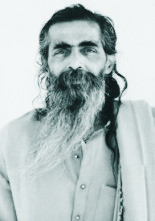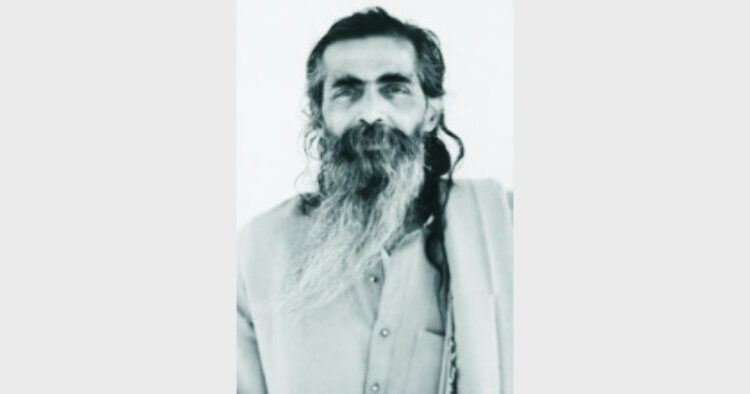Guruji—A drishta, not a Prophet?
S Gurumurthy?
Introduction?
 A series of thought provoking and profound articles titled Sri Guruji: A Drishta authored by Sri S Gurumurthy begins in Organiser from this week. The author had originally written on this subject as a long introduction to a book titled Reminiscences of Sri Guruji by Sri K Suryanarayana Rao, a veteran RSS worker, who has intense experience of and with Sri Guruji. The introduction of the author to the book on Guruji is being rewritten and serialised by the author specially for Organiser.
A series of thought provoking and profound articles titled Sri Guruji: A Drishta authored by Sri S Gurumurthy begins in Organiser from this week. The author had originally written on this subject as a long introduction to a book titled Reminiscences of Sri Guruji by Sri K Suryanarayana Rao, a veteran RSS worker, who has intense experience of and with Sri Guruji. The introduction of the author to the book on Guruji is being rewritten and serialised by the author specially for Organiser.
In his articles, the author studies, investigates, analyses and the far-reaching thoughts and expositions of MS Golwalkar, the second Sarsanghachalak of Rashtriya Swayamsevak Sangh (RSS) on the philosophical and ideological foundations of Hindu Nation and the unified but diversified cultural ethos of the Hindu society. The author explains how Golwalkar”s thoughts and expositions, heavily questioned and harshly criticised in his lifetime, have been validated and vindicated long after he had given expression to them. Madhav Sadhashiv Golwalkar, affectionately called by his students in Benaras Hindu University as “Guruji” – which name later stuck to him for life – laid the ideological foundations of the RSS and, by silent and sustained work, built it into a mighty socio-cultural, national movement under his leadership spanning over three decades.
He led the organisation through the pre and post Partition days, the most turbulent time in the recent history of India and also of the RSS. Post Partition, the most popular and powerful leadership of post Independent India, that had inherited the entire goodwill of the freedom movement, used that power and influence and banned the RSS on false and malicious charges that were later established to be fake and attempted to wipe it out. But the attempt failed and the RSS emerged out of the ordeal without blemish and became more and more powerful to finally emerge as the most powerful organisation in the country. How Guruji led the RSS at that critical time is a profound lesson and unprecedented example of outstanding leadership in crisis. And how the swayamsevaks, inspired and led by him, faced the onslaught of the pre-constitutional Indian government, that had no constitutional injunctions against use of state power, is story of high risk, sacrifices and courage for the RSS itself and the organisations inspired by it to study, imbibe and emulate in future. Guruji established the basic truth that, when everything goes against, an organisation sails through the crisis aided only by unwavering conviction in its foundational thoughts.
In the upcoming series, the author brilliantly and with illustrations, explains how, like all saints and seers spoke ahead of time, Guruji also looked beyond his times and at the future of India and the world, while placing his profound thoughts before their times had arrived. In his mission to keep the profound thoughts and the mission based on them alive through the complex and turbulent times, Sri Guruji repeatedly transcended the compulsions, the complexities and the arresting influences of the context in which he lived. The author explains how Guruji voluntarily, and even gladly, risked being misunderstood and faced unpopularity repeatedly tell the unpleasant truth contrary to the main and but superficial discourse of the day, to keep alive the foundational truths about this ancient nation deep in the inner consciousness of the people of the country.
The author draws a parallel between the dissent of Guruji to the main discourse of his times and the dissenting views against the majority judgement in judicial cases. Comparing Guruji”s dissent to the ruling ideas of his times to dissent by a judge in judicial proceedings differing from the majority judgement, the author says like the dissent by a judge in a judicial case is regarded as an appeal by the dissenting judge to the future conscience of the judiciary, the dissenting expressions of Guruji was an appeal to the future conscience of the people of India. The author quotes judicial authority that describes the philosophy of dissenting judgements thus: “A dissent … is an appeal to the brooding spirit of the law, to the intelligence of a future day, when a later decision may possibly correct the error into which the dissenting judge believes the court to have been betrayed.” The author says that it was in this spirit that Guruji, while keeping alive the fundamentals of this ancient nation in his times and through his thoughts and expositions, was making an appeal to the future conscience of the people and the leadership of India in various walks of life.
Who is a Hindu?
Both Indian and Western commentators tend to use such terms as “militant Hinduism”, “Hindu fundamentalism”, “religious revivalism”, or “reactionary Hinduism” to describe the ideology of the (RSS) movement, although these terms may seem inappropriate category for the study of Hindu religious phenomena. Hinduism is without foundation texts, defined dogmas, and institutional structures that are characteristic of most varieties of fundamentalism in other belief systems. This point of view finds frequent expression in modern Indian thinking, with emphasis on Hindu view of life as grounded in a spiritual experience that is essentially rational and humanistic.”
Resembles the speeches delivered decades ago by Guruji Golwalkar among his followers? Yes, it is Golwalkar”s thoughts. But not his words. Now go further.
“No precise meaning can be ascribed to the terms “Hindu”, “Hindutva” and ‘Hinduism’ and no meaning in the abstract can confine it to the narrow limits of religion alone, excluding the content of Indian culture and heritage”; “Ordinarily, Hindutva is understood as a way of life or a state of mind and is not to be equated with or understood as religious Hinduism.”
Rings like Guruji’s words uttered somewhere some half a century ago? Yes, it is his views. But not his words.
Neither of the two quotes are in Guruji”s words. But both carry Guruji”s thoughts. These views were expressed long after—actually three decades—after Guruji passed and several decades before that Guruji had expressed these very thoughts.
Fundamentalism Project in US agrees with Guruji decades later
The first quote, which contains Guruji”s thoughts but not in his words, is that what the editors of the five volume Fundamentalism Project of the American Academy of Arts and Sciences involving international group of scholars had approvingly allowed. It is an extract from the essay “The functioning of the Rashtriya Swayamsevak Sangh: To Define the Hindu Nation” by Ainslee T Embree. Embree’s essay is contained (at pages 618-619) in the book titled Accounting for Fundamentalisms: Dynamic Character of the Movements, p.617-52, Volume 4 Fundamentalism Project of the American Academy of Arts and Sciences; Chicago University Press ISBN: 0-226-50885-4). This book is the fourth of the mammoth five-volume research work on the emerging phenomenon of religious fundamentalism produced by the authors of the Fundamentalism Project in 1995, more than two decades after Guruji had passed away. The author has independently evaluated the ideological premises of the RSS – read Guruji”s thoughts – and accepted his thoughts almost in the very words Guruji had uttered them.
When the Fundamentalism Project says that “to use such terms as “militant Hinduism”, “Hindu fundamentalism”, “religious revivalism”, or “reactionary Hinduism” to describe the ideology of the (RSS) movement, although these terms may seem inappropriate category for the study of Hindu religious phenomena” it is only repeating what Guruji had said decades earlier. Guruji had also pointed out the difference between rejuvenated Hinduism and reactionary Hinduism and explained how rejuvenation of Hinduism is wrongly labelled as “revivalism” and “reactionary”. Guruji had been consistently and with mathematical precision, articulating the difference between “positive” Hinduism and “negative” or “reactionary Hinduism”. By taking the most sensitive issue of cow slaughter as an example Guruji says that while reinstating faith among Hindus in cow protection is positive Hinduism, the views of those Hindus who had opposed cow slaughter not because of love of cow, but because Muslims kill them constituted “reactionary” and “negative” Hinduism (Bunch of Thoughts (p. 70) Book comprising the speeches of Guruji given over decades compiled in 1960 and printed and published as the first edition 1966: publishers: Jagarana Prakashana; Kempegowda Nagar; Bengaluru-560019). More on the Fundamentalism Project and how their view agrees and approves of Guruji”s thoughts in the later parts of the series.
(To be continued)?
About the Author?
 Swaminathan Gurumurthy, popularly known as S Gurumurthy, is a well-known writer, journalist and a respected corporate adviser. Hamish McDonald, well-known Australian journalist, wrote in his book Polyester Baron, that Shri Gurumurthy had ‘a strong sense of probity’. Highly rated for his investigative exposes, Shri Gurumurthy has been ceaselessly campaigning against corruption at high places since mid 1980s. Hamish McDonald also wrote in his book that Gurumurthy’s investigative work “must rank among the most powerful examples of investigative journalism anywhere in the world”.
Swaminathan Gurumurthy, popularly known as S Gurumurthy, is a well-known writer, journalist and a respected corporate adviser. Hamish McDonald, well-known Australian journalist, wrote in his book Polyester Baron, that Shri Gurumurthy had ‘a strong sense of probity’. Highly rated for his investigative exposes, Shri Gurumurthy has been ceaselessly campaigning against corruption at high places since mid 1980s. Hamish McDonald also wrote in his book that Gurumurthy’s investigative work “must rank among the most powerful examples of investigative journalism anywhere in the world”.
Indian Institute of Technology Mumbai invited Shri Gurumurthy to run a course on the Indian economic, business and financial model for the MBA students this year. He is now a Visiting Faculty at IIT Mumbai. He is also a Distinguished Professor in Tumkur University to guide their economic research team. His intellectual and professional credentials are well-known. Business Baron magazine rated his knowledge of economics, finance and accounts as “outstanding”. His range of interest and knowledge touch upon a complex set of disciplines including religion and philosophy, history and culture, economics and sociology. Contrary to so-called modern view, which believes that tradition and contemporary world cannot co-exist, he believes that, for most majority people, tradition does not contradict the contemporaneous world, but actually acts as an anchor to handle it.?













Comments